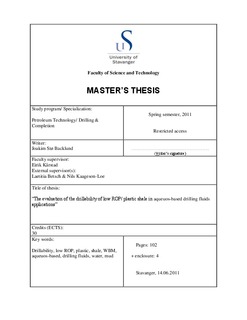| dc.description.abstract | As the age of petroleum is rapidly progressing forward, the need to drill deeper and more challenging wells to access and exploit oil and gas reservoirs is increasing. The industry is constantly being challenged to find new and better solutions to the problems that drilling these types of wells create, and one area in particular that has required a lot of research and development is the drilling of shale formations. Since shale formations make up more than 75% of all the drilled formations, and contribute to more than 90% of wellbore instability problems, it has been of everyone`s interest to develop new equipment and methods to try and solve these issues.
The solution to most of these problems has been to use an oil based mud (OBM) system when drilling through the different shale formations. The OBM effectively prevents any unwanted chemical reaction or swelling from occurring and helps maintaining a decent wellbore stability and ROP. The problem with using an OBM however is that it poses a severe environmental and economical threat. Due to strict national regulations, an unintentional spill caused by leakage in the system can become very costly.
Because of these issues operators have looked at other alternatives to the traditional OBM such as water based mud (WBM). The WBM is relatively cheaper compared to the OBM and it does not have the same types of health, safety and environment (HSE) problems. Cuttings can therefore, in some parts of the world, be dropped directly on the sea floor. This can be a great advantage in areas where cuttings transport through the riser up to the surface is difficult, and transporting contaminated cuttings to shore is expensive.
However, there is a downside with WBM systems when drilling in deep shale formations. The drilling rate drops dramatically and very little progress is made. Even though the problem is known by the industry, the actual cause of the problem is not. Several theories attempt to explain it and many possible solutions have been developed based on them. The study of these theories, suggested solutions and real well cases with low drilling rate problem in shale formations has yielded some interesting results. Based on the real well case studies, parameters such as the weight of the drilling fluid, its flow rate, drilling fluid additives, drill bit type and drill bit design all seem to have a significant role in affecting the drilling rate in deep shale formations. By considering the results obtained in this thesis and applying the suggestions in future well operations it could potentially be possible to improve the drilling rate and reduce costs. | en_US |
